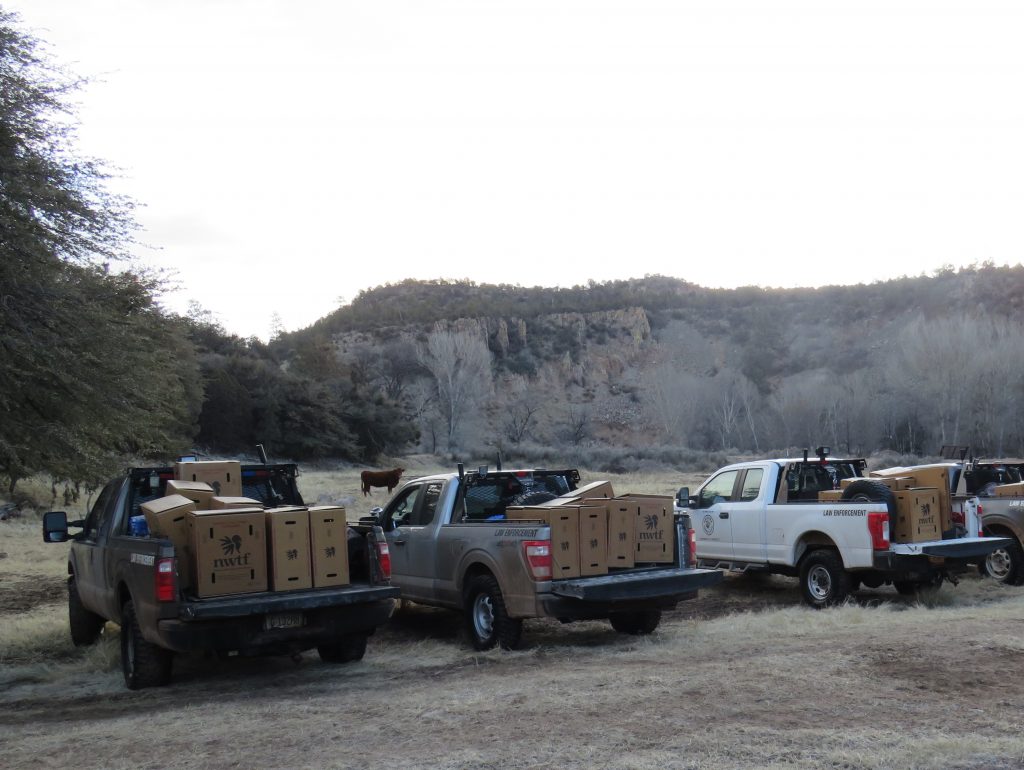Revolutionizing Turkey Conservation in Arizona: How GPS Tech and Soft Releases Are Changing the Game
For the past several years, Arizona Game and Fish Department (AZGFD) biologists have been working on a game-changing research project aimed at answering a critical question: What exactly happens to wild turkeys after they're translocated to new habitats?
Driven by inconsistent results from past turkey translocation efforts — particularly in Arizona’s Game Management Unit 22 — Mesa Region’s Wildlife Specialist Dustin Darveau and Field Supervisor Joe Sayer along with the Pinetop Region’s Terrestrial Wildlife Program Manager Rick Langley set out to find the answer. What began as a straightforward look into turkey survival quickly evolved into one of the most informative wild turkey studies in recent state history.
Thanks to GPS technology and an evolving understanding of wild turkey behavior, the research is now helping shape future wildlife management decisions in Arizona — and beyond.
In 2022, with funding from a private donor, the research team was able to replace their basic VHF radio tags with GPS backpack transmitters. This upgrade offered a real-time, high-resolution window into turkey movements and behavior. It also uncovered surprising insights.
“One of the most significant things we learned early on was how much habitat type mattered,” Darveau explained. “We saw birds leaving the release site altogether and climbing 800 to 1,000 feet in elevation to reach habitat similar to where they came from. It made us realize how important it is to match the source and recipient environments.”
By adjusting release strategies based on this finding, such as matching habitat types and employing more controlled release methods, the team saw an almost immediate improvement in the survival and residency rates of the translocated birds.
The use of GPS data also revealed that turkey nesting activity in Arizona may be happening significantly later than previously thought. Research from decades ago shaped current hunting season structures, but these new findings suggest that some hunting may occur before peak breeding.
This raises an important question: Could male turkeys be harvested before they have the opportunity to breed, reducing successful reproduction and impacting population recovery?
Preliminary findings indicate that may be the case in this initial study area, but additional research is needed.
“If we find consistent results across multiple game management units and habitat types across the state, we could recommend changes to hunting season dates to better align with breeding and nesting,” Darveau said.

Additional data is already being put to use by local USDA Forest Service offices, who are adjusting the timing of habitat treatments like prescribed burns and timber thinning to avoid disrupting nesting activity.
With the help of the National Wild Turkey Federation, through the organization’s National Request for Proposals Program 2024 funding, the research has begun to expand into new areas, with the goal to build a statewide dataset that can inform turkey management for years to come.
Future phases of the project will not only continue monitoring survivability and nesting success but also analyze fall habitat use and the impact of drought and hunting pressure — especially on hens.
“We’re seeing more hens harvested, which could impact future recruitment,” Darveau said. “This research will help us figure out how to mitigate that.”
Perhaps the most exciting aspect of the project is how quickly the new release technique is being adopted elsewhere. From Arizona to Utah and beyond, states are taking note of the improvements in translocation success.
In their previous and current research, Darveau and Sayer have also tested a new approach to releasing trapped wild turkeys, coined the “flock release.” Traditional turkey releases often involved simply opening NWTF transport boxes and letting the birds scatter. With the soft release, instead of abrupt freedom, turkeys were held briefly in a shaded, enclosed area before being calmly released. This method gave the birds time to regroup and reduced their initial stress — a critical factor in early survivability.
“The difference was night and day,” Darveau said. “We went from seeing 30–60% mortality in the first two months to nearly zero. The birds stayed together, moved as a unit, and integrated into the habitat more smoothly.”
So effective was this strategy that other states, including Utah, are now adopting the practice for their own translocation efforts.
For Darveau, Sayer, Langley and their team, the goal isn’t just about Arizona’s turkeys — it’s about contributing to a bigger picture of wild turkey conservation across the country.
“It’s been a joy to share this with other states,” Darveau said. “If we can help improve turkey conservation beyond our borders, that’s a win for everyone — especially the birds.”

As wild turkey populations face challenges across the country, from habitat loss to climate stress, Arizona’s innovative approach is paving the way for a more informed and effective style of wildlife management. With data-driven insights, creative release techniques and strong partnerships, the future of wild turkeys in the West is looking a little more secure.
The NWTF invested funds into the above project along with eight other wild turkey research projects across the United States, totaling $655,447 for the organization's 2024 allocation.
Since 2022, with partner funds leveraged at more than a 10-to-1 ratio, the NWTF, its chapters, members and partners have combined to put more than $18 million toward wild turkey research. This number will increase as the NWTF's national Science and Planning team is slated to fund more wild turkey research projects this year.
Thanks to support from dedicated partners — such as the Bass Pro Shops and Cabela’s Outdoor Fund, Mossy Oak and NWTF state chapters — the RFP program is an aggressive, annual effort to fund critical wild turkey research projects nationwide.
